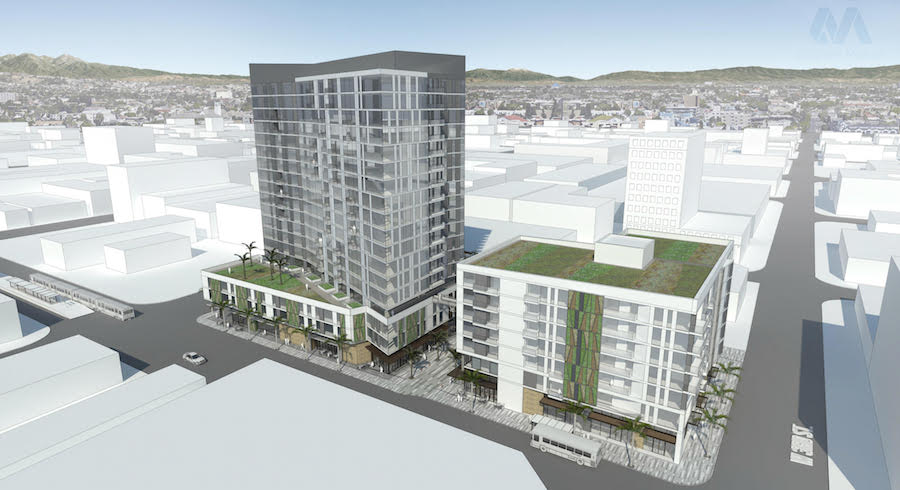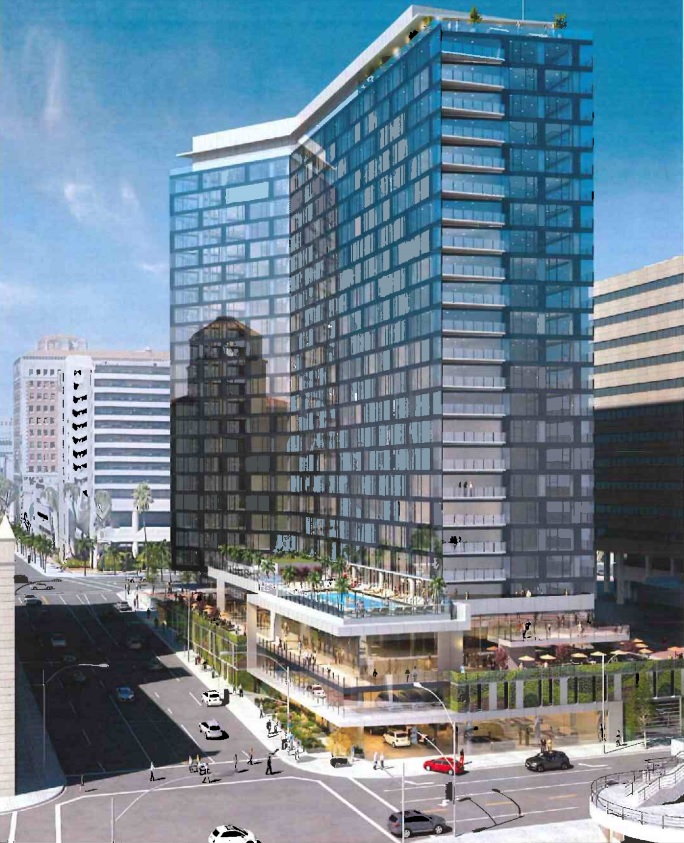
File photo of the Downtown Long Beach skyline, (below) renderings of proposed structures to be built in the Downtown Project Area.
Downtown Long Beach has changed considerably over the last few decades, with crime reaching historic lows and developments springing up at an accelerating pace. At the current pace of parcel sales being approved by the Long Beach City Council, downtown could be nearly unrecognizable by the end of the decade.
On Tuesday, the council is slated to approve yet another sale, this time of the final former Long Beach Redevelopment Agency (RDA) land parcel—the agency was officially dissolved in February 2012—to a Laguna Niguel-based developer that aims to reshape the vacant lot just blocks from the Long Beach Performing Arts Center.
In a $7.3 million deal, Raintree-Evergreen, LLC is set to acquire the lot that sits at the southwest corner where Long Beach Boulevard intersects Broadway, where the group intends to install modern luxury apartments and retail space. Just last month, the same group secured the lot located at Broadway and the Promenade North adjacent to Congregation Ale House for $8.2 million.
The projects proposed by Raintree at the Promenade promises to keep 20 parking spots available for the historic Insurance Exchange Lofts located to the north of the proposed site, however, the site acquired last night makes no mention of parking spots being retained. Both project sites are currently parking lots that serve area businesses and residents but they were never intended to be permanent, according to Long Beach Director of Economic and Property Development Mike Conway.
“The adjoining property owners have enjoyed three years of available public parking but it was never the intention to leave those as public parking lots,” Conway said. “It was always intended to be developed, we’ve just been delayed by three years.”
 Mayor Robert Garcia noted that the issue of parking, and how an influx of new construction projects in the downtown area will impact the city, will be an ongoing discussion during last week’s city council meeting. The mayor added that while the city is cognizant of parking needs for downtown residents, and that those needs are spelled out in the city’s plans, creating urban density also means catering to a new generation of people who might not necessarily need parking spaces.
Mayor Robert Garcia noted that the issue of parking, and how an influx of new construction projects in the downtown area will impact the city, will be an ongoing discussion during last week’s city council meeting. The mayor added that while the city is cognizant of parking needs for downtown residents, and that those needs are spelled out in the city’s plans, creating urban density also means catering to a new generation of people who might not necessarily need parking spaces.
“We want to make sure that if we build developments there is adequate parking but we also know that a lot of people that are moving into downtowns don’t have cars,” Garcia said. “We also know that a lot of people moving into downtowns are taking Metro to Downtown LA. There’s a mix and we have to make sure that we have parking but we also have to make sure that we understand that some people don’t want or need two parking spaces.”
In both instances Raintree was the highest bidder in the city’s outreach efforts. The sale of property continues a trend that has seen the council sell off old RDA plots at 3rd and Pacific and the old Jergins Trust Building at Pine and Ocean in recent weeks. The two Raintree projects—both projected to have construction completed by the end of Fall 2019—combined with other projects and the construction of the new Civic Center will dramatically change the downtown core’s skyline if all projects are completed on time.
Conway said that price wasn’t always the determining factor in the sale of these former RDA properties, but what carried the most weight was whether it fit into the city’s strategic plan for creating density and fulfilling outlined needs in the downtown sector like jobs and retail to help activate previously blighted or empty lots.
“With the future development sites we weren’t focused on the highest price as much as we were on the type of development,” Conway said. “We wanted development that supports the strategic guide of the project area in which its located and provides an identified need in the local community and generates jobs.”
Between the two projects the city could potentially receive around $2.7 million that will be divided between the downtown project area (75 percent) with the remainder being disbursed for programs citywide. The projects are estimated to generate between 80 and 100 permanent jobs once construction is completed.
Eight such properties have been sold in the last calendar year for the development of future projects. At one point, Conway said that the city had about 240 properties that were either for sale, marked for government uses like parks and libraries, set aside for future developments and one that was an “enforceable obligation,” which has now become The Current.
 In total, the sale of the RDA properties in downtown Long Beach are scheduled to generate about $35 million in gross sales revenue, which Conway said should equal to about $7 million that the city will use to help support small businesses in the city as well as efforts to draw in new businesses from other regions. He said that while the programs haven’t been established yet, they could eventually be a source of “angel funding” for startups and improving infrastructure for existing businesses.
In total, the sale of the RDA properties in downtown Long Beach are scheduled to generate about $35 million in gross sales revenue, which Conway said should equal to about $7 million that the city will use to help support small businesses in the city as well as efforts to draw in new businesses from other regions. He said that while the programs haven’t been established yet, they could eventually be a source of “angel funding” for startups and improving infrastructure for existing businesses.
Conway has seen the process come full circle, literally. When he came on with the city in the early 2000s he was charged with the task of buying up many of these properties for the RDA, and on Tuesday, he’ll see the final remaining plot in downtown be sold off. What’s an economic and property manager supposed to do with a dearth of plots to develop?
“I’m retiring,” Conway said with a chuckle.
The votes by the council to sell the properties to Raintree, or to other developers, were not an approval for the proposed projects, which will still be subject to state laws regarding outreach and environmental impact reports. Part of those processes will surely include discussions on parking, a hot-button issue that has sparked some residents in Downtown to protest the influx of projects.
Garcia is standing firm on his long-held belief that the city needs density to thrive. He said that these projects will not only create short term construction jobs, but long-term retail jobs as well. Past that, he said the properties themselves will help generate revenue in the form of taxes that will benefit the city outside of the footprint of downtown in the form of increased spending on public safety and infrastructure repairs.
Building a stronger urban core, though, will require engaging that core of residents who already call downtown Long Beach home. The mayor, while hopeful of meeting his goal of bringing thousands more people to live in the heart of the city, said that it won’t be done without community input or with the absence of housing that’s available to a variety of socio-economic brackets.
“An additional ten thousand people living downtown I think would strengthen the retail picture, it’s good for restaurants, good for the economy and it would overall drive growth,” Garcia said. “That’s a goal, it’ll take us a decade to get there, but we’ve got to do it in a way that’s smart.”
{FG_GEOMAP [33.7692766,-118.18949279999998] FG_GEOMAP}

